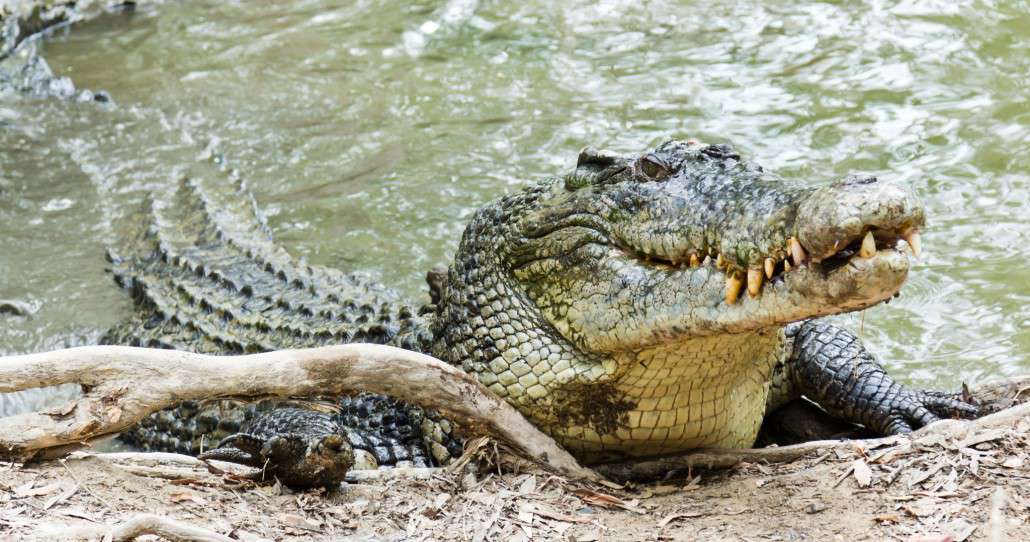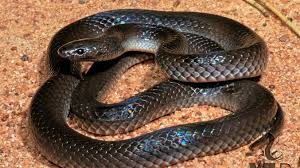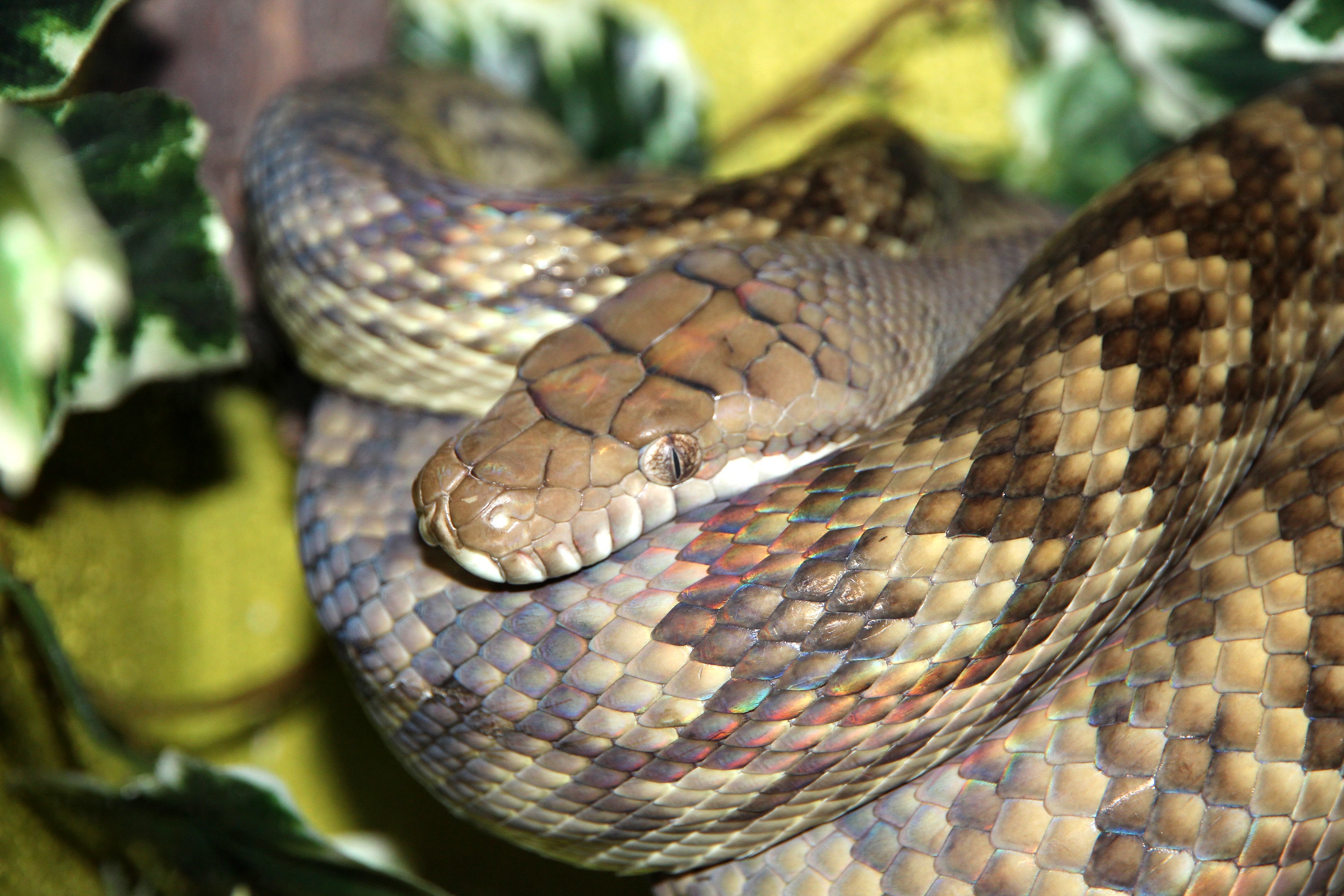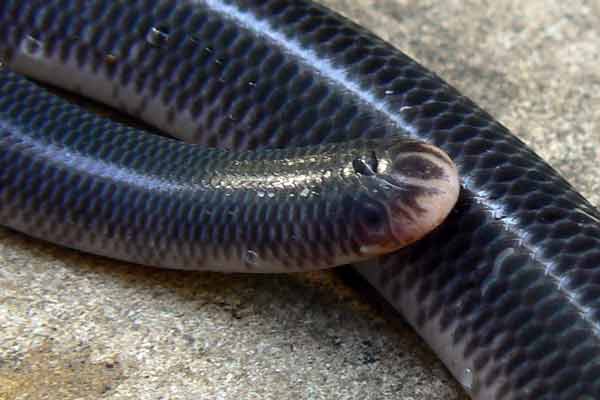Fauna and Flora of Cape Tribulation and the Daintree Rainforest
Fauna (continued)
Reptiles - Crocodiles
Saltwater crocodile
 The saltwater, or estuarine crocodile, Crocodylus porosus is one of Australia's and the Daintree's biggest, scariest animals and possibly the most dangerous. These huge (up to 6 or more metres in length) animals, little-changed from the days of the dinosaurs, are highly efficient predators, capable of rapid motion when hunting and having one of the most forceful bites in the animal kingdom. The name "saltwater crocodile" is a bit of a misnomer as they can tolerate water with a wide range of salinities, from no salt to water twice as salty as average sea water. Their salinity tolerance means they can be found in a wide range of environments, from offshore waters to inland creeks (Swimmers beware - unless you're taking your dip in a cement pool, you may have more company than you've bargained for!)
The saltwater, or estuarine crocodile, Crocodylus porosus is one of Australia's and the Daintree's biggest, scariest animals and possibly the most dangerous. These huge (up to 6 or more metres in length) animals, little-changed from the days of the dinosaurs, are highly efficient predators, capable of rapid motion when hunting and having one of the most forceful bites in the animal kingdom. The name "saltwater crocodile" is a bit of a misnomer as they can tolerate water with a wide range of salinities, from no salt to water twice as salty as average sea water. Their salinity tolerance means they can be found in a wide range of environments, from offshore waters to inland creeks (Swimmers beware - unless you're taking your dip in a cement pool, you may have more company than you've bargained for!)
Reptiles - Snakes
Far North Queensland, including the Daintree Rainforest near Cape Tribulation, has many different kinds of snakes which fall into one of four categories:n: elapids (front-fanged), colubrids (back-fanged and solid-fanged), pythons (boids), and blind snakes (typhlopids). Many snakes in the Daintree area are quite beautiful, with bright colours or intricate patterns, especially the pythons.
Elapids
Eastern small-eyed snake
 Although elapids worldwide include some of the most-venomous snakes knownn, the ones found in the Daintree area, such as the Eastern small-eyed snake, Cryptophis nigrescens tend not only to be less-venomous, but shy, even secretive by nature, and not inclined to bite. (The small-eyed snake is also nocturnal.) Extremely dangerous elapids like the death adder, the taipan, and the red-bellied black snake have been sighted in the Daintree Rainforest, but they are very uncommon as they tend to prefer dryer areas.
Although elapids worldwide include some of the most-venomous snakes knownn, the ones found in the Daintree area, such as the Eastern small-eyed snake, Cryptophis nigrescens tend not only to be less-venomous, but shy, even secretive by nature, and not inclined to bite. (The small-eyed snake is also nocturnal.) Extremely dangerous elapids like the death adder, the taipan, and the red-bellied black snake have been sighted in the Daintree Rainforest, but they are very uncommon as they tend to prefer dryer areas.
Colubrids
Green tree snake
 The colubrid snakes of the Daintree such as the green tree snake (Dendrelaphis punctulata) are either non-venomous or only weakly venomous. None is dangerous to humans, although some are ready biters if provoked.
The colubrid snakes of the Daintree such as the green tree snake (Dendrelaphis punctulata) are either non-venomous or only weakly venomous. None is dangerous to humans, although some are ready biters if provoked.
Pythons
Amethystine python
 The pythons, which are non-venomous and kill by constriction and suffocation, represent a risk to both humans and domestic animals, the degree of risk being proportional to the size of the snake. The most-common python in the Daintree area is the amethystine python, Morelia amethistina; the largest amethystine python on record was measured at 8.5 metres (about 28 feet). A snake that size can easily overcome and eat an adult human - even a much-smaller python can attack and eat dogs, cats, chickens, and even small children.
The pythons, which are non-venomous and kill by constriction and suffocation, represent a risk to both humans and domestic animals, the degree of risk being proportional to the size of the snake. The most-common python in the Daintree area is the amethystine python, Morelia amethistina; the largest amethystine python on record was measured at 8.5 metres (about 28 feet). A snake that size can easily overcome and eat an adult human - even a much-smaller python can attack and eat dogs, cats, chickens, and even small children.
Blind Snakes
 The blind snakes, genus Ramphotyphlops (true snakes - not to be confused with their sometimes similar-looking relatives, the legless lizards) are nearly-eyeless burrowers which look a bit like earthworms. They are incapable of biting humans (or anything much larger than the termites on which they prey) and are completely harmless.
The blind snakes, genus Ramphotyphlops (true snakes - not to be confused with their sometimes similar-looking relatives, the legless lizards) are nearly-eyeless burrowers which look a bit like earthworms. They are incapable of biting humans (or anything much larger than the termites on which they prey) and are completely harmless.

